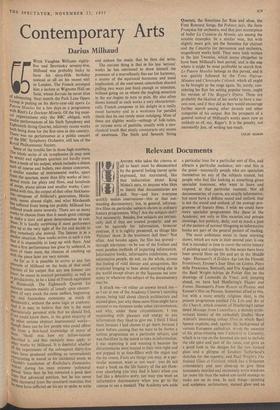Contemporary Arts
Darius Milhaud
WITH Vaughan Williams eighty- five and Stravinsky seventy-five, Milhaud was probably lucky to have his sixty-fifth birthday noticed at all on his recent visit to London. The French arranged him a lecture at Wigmore Hall on Satie, whose Socrate he never tires of advocating. Next month the Park Lane Opera Croup putting on his thirty-year-old opera Le Pauvre Matelot for a few days in a programme with Bizet's Le Docteur Miracle. Of the big musi- cal organisations only the BBC obliged, with studio performances of his Sixth Symphony and Ighteenth String Quartet, relatively recent works _both being done for the first time in this country. There was no performance at a public concert of the BBC Symphony Orchestra, still less of the Royal Philharmonic Society.
,,,Some of the trouble lies in those high numbers. The whole series of six symphonies (it may now be seven) and eighteen quartets are hardly more than a tenth of his output, which includes a dozen e,,ach of operas and ballets, two dozen concertos, ; similar number of instrumental works, apart from thequartets ,
more than fifty works of inci- dental music for plays and films, and hundreds Pacengs, piano pieces and smaller works. Corn-
le with this, the output of.that other Stakhano- ,„ , composer of Milhaud's generation, Hinde- mith, seems almost slight, and what Hindemith has suffered from being too prolific Milhaud has suffered much more severely. There are so many Works to choose from that it needs great courage to make a start and great determination to con- tinue. It is hardly surprising if most performers !,‘'e op at the very sight of the list and decide to '41' somebody else instead. The listener is in a „ ar situation. New works arrive at such a rate that it is impossible to keep up with them. And once a first performance has gone by unheard, as ,,.°).°st of them must, the chances of catching up with the piece later are very remote. As far as it is possible to arrive at any fair fraction of Milhaud on the basis of that small traction of his output that any one listener can k "w, he seems in musical personality, as well as of Productivity, to be a kind of French equivalent Hindemith. The Eighteenth Quartet for instance consists mainly of loosely spun counter- roInt of very much the same endless, beginning- less and featureless monotony as much of And without the same logic or euphony. 4nd it is easy to believe that this is the most characteristic personal style that we should find, tf vie could know them, in the great majority of 's other serious abstract instrumental works— though there can be few people who could affirm this from a first-hand knowledge of many of them 'Shrill' was how my fellow-listener described it, and that certainly does apply to other works by Milhaud. It is doubtful whether all the experiments of the subsequent thirty-five ears have produced anything so remorselessly excruciating in sound as his incidental music to written translation of IEschyius's Eumenides. ,.,„rttten during his most extreme 'polytonal' riocl. Since then he has retreated a good deal ',°°1 that advanced position, but he has never recovered from the unnatural exercises that he Must have inflicted on his ear in order to write
and endure the music that he then did write.
The curious thing is that in his less 'serious' works he has continued to show himself the possessor of a marvellously fine ear for harmony, a master of the equivocal harmonic and tonal implication, of the sour-sweet concordant discord pulling two ways just hard enough to stimulate, without going on to where the tingling sensation in the ear begins to turn to pain. He also often shows himself in such works a very characteristi- cally French composer in his delight in a really sweet harmony and in a weakness for parallel thirds that he can rarely resist indulging. Most of these are slighter works—settings of folk-tunes, or various sorts of pastiche, usually with a neo- classical touch that nicely counteracts any excess of sweetness. The Sixth and Seventh String Quartets, the Sonatinas for flute and oboe, the Four Ronsard Songs, the Poetnes fulls, the Suite Francaise for orchestra, and that jazz masterpiece of ballet La Creation du Monde, are among the notable examples. In a similar vein, but with slightly more grit, are the Sonatina for clarinet and the Concerto for percussion and orchestra, magnificent works both. They were both written in the late Twenties, which seems altogether to have been Milhaud's best period, and is the one where it might be most profitable to search first. Le Pauvre Matelot belongs to this period, and it was quickly followed by the Trois. Operas- Minutes and Christophe,Colomb, which all ought to be brought to the stage again. So, surely, con- sidering his flair for setting popular tunes, ought his version of The Beggar's Opera. These are probably the likeliest of his works to have a suc- cess now, and if they did so they would encourage further search among other periods and other Categories of his output. But the prospects of a general revival of M ilhaud's works seem now as unlikely as of, say, Reger's. It is the penalty, not necessarily just, of writing too much.
COLIN MASON










































































 Previous page
Previous page